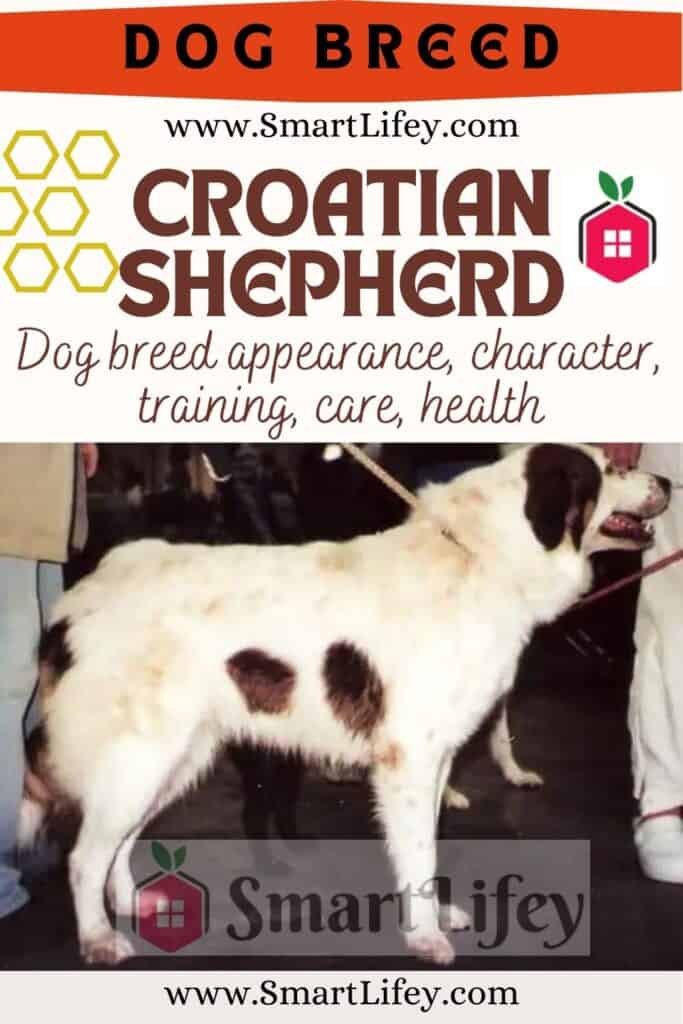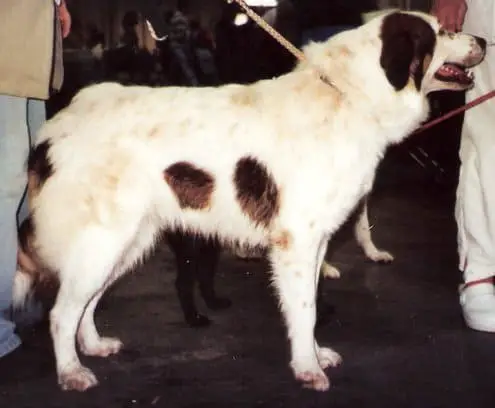
The Croatian Shepherd breed is agile, courageous and very faithful. Unfortunately, the fame of this dog has barely crossed the borders of its original Croatia. It has shown its ability to develop other types of jobs, but few people have it as a pet despite its good characteristics and character. At Petlifey, we explain everything about the Croatian Shepherd.
Characteristics of the Croatian Shepherd breed
The Croatian Shepherd is a lively, energetic dog, with an intelligent look and always alert. Excellent at herding work , it is also a great companion dog, with a docile and affectionate character. It is also known by the name Croatian Sheepdog, Berger croate , Kroatischer Scháferhund or Hrvatski Ovcar.
On the other hand, its beautiful fur of an intense black color makes it a specimen of beautiful and elegant appearance.
Let’s see in more detail its physical characteristics, its character and behaviour:
Physical characteristics of the Croatian Shepherd
The Croatian Shepherd is a rustic dog. Its coat is black and tight, especially on the face and on the extremities, areas that may be more prone to the formation of knots, and the rest of the coat is wavy, with not very tight curls, semi-long and with a strong texture.
- General appearance: It is an agile dog, with a bright coat. The short hair on the head and the limbs is an identification of the breed. It is medium in size and is characterized by having short, black, wavy hair on its head.
- Size: Medium.
- Height at the withers: 50 cm (Male) and 40 cm (Female).
- Weight: 8-15 kg (Male) and 7-14 kg (Female).
- Body: The body silhouette of this dog is rather rectangular, since the length of the body slightly exceeds the height at the withers, which is about 45 cm in both males and females. The passage from the neck to the back is gradual and barely visible. Its back is short, muscular, like the loin, with the rump of medium length, slightly oblique, well muscled and of notable width.
- Head: Light and wedge-shaped, the skull tapers towards the muzzle, which is not very fleshy and has a straight profile, with an always black and not very prominent nose. It has very developed brow ridges and rounded cheeks, although overall it is not very muscular. The frontal sulcus is not very marked.
- Muzzle: Straight in profile and wedge-shaped, continuing the upper part of the skull and not too pointed, but not blunt either.
- Nose: Black and not prominent in relation to the muzzle.
- Eyes: Medium in size, almond-shaped with a lively expression. They are dark in color that fluctuates between brown or chestnut and black. The eyelids are dark pigmented.
- Ears: They are triangular, erect or semi-erect and of medium length; they are inserted slightly to the sides. It is forbidden to cut off its ears.
- Nose-frontal depression (stop): It is moderate.
- Jaws: They are strong, with well developed teeth and a complete and perfect scissor bite.
- Neck: It is oblique in relation to the upper line of the back; its upper and lower lines are straight. It is moderately long, broad, muscular, and well arched but not overly strong. The skin on the neck has no folds and the hair covering is dense.
- Chest: Of medium length, it is quite deep, with well-fitting ribs and a not very pronounced fore chest. The profile of the chest continues that of the lower edge of the neck.
- Forelimbs: They are straight, of medium length and, seen from the front, they are parallel. The angles, quite open, cause a rather steep position of the dog. The shoulders are slightly oblique, of medium length and very muscular. Forearms and arms are long and well muscled.
- Hind limbs: They have moderately open angulations. Viewed from behind, they are parallel. The legs are rather long, they have moderately wide and muscular thighs. The hocks are close to the ground, well developed, with a fairly open angle.
- Feet: They are small and elongated, the back ones a little longer than the previous ones. Their fingers are close together, with black or grey nails, and thick pads. The hind hooves are slightly longer than the previous ones.
- Tail: Set moderately high and covered with long, bushy hair. At rest, the dog carries it low or level with the line of the back, but when alert, it carries it above. Some puppies can be born without a tail, and others are cut so that it does not exceed four centimeters in the adult dog.
- Skin: It is loosely fitted, without forming folds.
- Hair: It has a double coat. The internal is dense, and the external, soft, with wavy or curly hair, but not woolly. On the back the mantle is long. The face and the outer part of the ears are covered with short hairs, and behind the forearms it shows off thick and long fringes. In the hind limbs the hair widens forming a kind of “pants”.
- Color: The background tone of the hair is black, but sometimes the animal has some white markings under the throat and chest.
- Movement: The dog’s preferred movement is the trot, and it is moderate in range.
Character of the Croatian Shepherd
Modest and frugal, this dog is content with very little. It seems to feed on the satisfaction of accomplished duty and can go long periods without food, surviving on wild herbs and berries if the situation calls for it.
Despite its small size, it is a brave dog, courageous and devoted to its own, which is why it also turns out to be a good guardian.
If you are not grazing, you must exercise daily to maintain proper physical shape and consequent mental balance.
On the other hand, the lack of exercise, activities or tasks to do, cause the animal to get bored, and, idly, the Croatian Shepherd can become a destructive, noisy and sullen dog.
Some puppies even show a tendency to aggressiveness, which is easily corrected with proper training.
- Energy: High level. It is a very active shepherd dog that needs regular exercise.
- Temperament: It is a dog with a lively and attentive character, complacent with its master, sober and easy to please and educate.
- Adaptability: Low. It needs to do a lot of physical exercise, because if it does not become a destructive and noisy animal, it needs field and open spaces.
- Sociability: High. It is a dog with a brave temperament and very devoted to its family, but it is distrustful and sullen with strangers.
- Health: Very good. It is not prone to hereditary diseases, as the offspring have always maintained high levels of sanitary control.
- Longevity: High. Live between 12 and 14 years on average in good condition.
- Utility: Versatile. Due to its good character, it can be trained for numerous activities: shepherd dog, guard dog, companion dog or obedience and agility competitions.
Croatian Shepherd Education and Training
The Croatian Shepherd is a lively dog, but at the same time modest and easy to train. It is aware at all times of its master and the work that is entrusted to them.
At first it was used exclusively for sheep herding, and it is not uncommon to see how the dog, in its eagerness to fulfill its mission, is able to run over the sheep in the herd to reach the desired point earlier.
Due to its natural ability, it can herd any type of livestock, such as pigs and cows, and even geese, and some experienced shepherds assure that their dogs know each of the components of the herd by name.
The education and socialization of the Croatian Shepherd should begin at a very early age, because if it is not introduced from a puppy in the relationship with different people, it can be sullen and distrustful with strangers.
Like many other herding dogs, the Croatian Shepherd uses its voice, that is, the bark, when doing its job; Thus, if it is not trained from the beginning, it can become a noisy, very barking dog.
The main function of the Croatian shepherd with the flock is that of grouping and leading, for which it needs to have four fundamental qualities; speed, memory, courage and endurance.
The combination of all of them makes this breed a fundamental work tool for ranchers and shepherds, although it also excels in other types of activities, such as obedience and agility.
Croatian Shepherd diet
Regarding its diet, this breed needs an average contribution that ranges between about 1150 and about 1,250 kcal/day, although, as mentioned, it can endure long periods without eating.
In this sense, if the specimen is going to be used as a companion animal, with a more domestic life, the amount of food that is administered must be closely monitored, especially the contribution and origin of the fats that are provided. , and control that it does the necessary exercise, otherwise the animal will show a tendency to obesity, and a fat dog is never a healthy or happy dog.
Croatian Shepherd Health
This breed enjoys excellent health. As it is little known and has not stopped developing its original work, the breeding has been maintained over the centuries with strictly functional criteria, for which reason only the specimens that have proven to be healthier and balanced.
It is, therefore, a healthy breed of dog, without serious hereditary problems.
Some puppies are born tails, that is, without a tail; But, if not, an ancient custom had their tails cut off at the second or third vertebrae.
In the same way, after a few weeks of life, their dewclaws were amputated to avoid later problems during their work in the field.
Currently, both practices are prohibited in many countries. Fortunately, it is really very absurd to spoil the graceful silhouette with which nature gave this interesting, faithful and beautiful animal.
Croatian Shepherd care

As it does not make large changes of hair, to keep it in perfect condition, regular brushing is enough .
With a double-sided brush: metal bristles on one side and bristles on the other. Despite being a pedigree dog, it has a very simple care.
